英语句型转换之一肯定句变否定句的方法技巧
小学英语句型转换整理
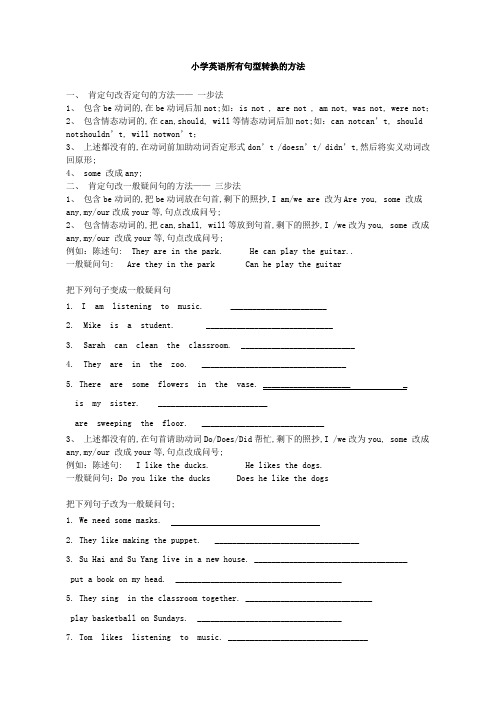
小学英语所有句型转换的方法一、肯定句改否定句的方法——一步法1、包含be动词的,在be动词后加not;如:is not , are not , am not, was not, were not;2、包含情态动词的,在can,should, will等情态动词后加not;如:can notcan’t, should notshouldn’t, will notwon’t;3、上述都没有的,在动词前加助动词否定形式don’t /doesn’t/ didn’t,然后将实义动词改回原形;4、 some 改成any;二、肯定句改一般疑问句的方法——三步法1、包含be动词的,把be动词放在句首,剩下的照抄,I am/we are 改为Are you, some 改成any,my/our改成your等,句点改成问号;2、包含情态动词的,把can,shall, will等放到句首,剩下的照抄,I /we改为you, some 改成any,my/our 改成your等,句点改成问号;例如:陈述句: They are in the park. He can play the guitar..一般疑问句: Are they in the park Can he play the guitar把下列句子变成一般疑问句1. I am listening to music. ______________________2. Mike is a student. _____________________________3. Sarah can clean the classroom. __________________________4. They are in the zoo. _________________________________5. There are some flowers in the vase. ____________________ _is my sister. _________________________are sweeping the floor. ____________________________3、上述都没有的,在句首请助动词Do/Does/Did帮忙,剩下的照抄,I /we改为you, some 改成any,my/our 改成your等,句点改成问号;例如:陈述句: I like the ducks. He likes the dogs.一般疑问句:Do you like the ducks Does he like the dogs把下列句子改为一般疑问句;1. We need some masks.2. They like making the puppet. _________________________________3. Su Hai and Su Yang live in a new house. ___________________________________put a book on my head. ______________________________________5. They sing in the classroom together. _____________________________play basketball on Sundays. _________________________________7. Tom likes listening to music. ________________________________三、肯定句改特殊疑问句的方法——四步法1、句首添加特殊疑问词根据划线部分确定是什么疑问词;2、划线部分去掉;3、把剩下的句子按照改一般疑问句的方法改完;特例:How many询问数量后紧接物品,EG: How many kites can you see/ How many books are there on the desk 等4、查补某些特殊的句型需要添词或减词;句号改成问号;句型转换题1. The girl is singing in the classroom.改为否定句改为一般疑问句2. They are looking for bag.对画线部分提问3. I am riding my bike now.同上4. There are twelve studens over there.同上5. I can speak English.改为一般疑问句6. I am writing now.同上7. I have a desk and a chair.用He做主语改写句子8. She is buying some food in the supermarket.改为否定句9. I am ill. 对画线部分提问10. Does she like growing flowers 给予否定回答11. I will make model planes with my classmates on Sunday. 对画线部分提问12. The girl dances beautifully.改为感叹句13. The waiter and the waitress play table tennis every day. 改为否定句14. The boy is standing on the man's shoulders.改为一般疑问句15. It's ten o'clock.对画线部分提问关于特殊疑问词组针对人提问谁 /何人 who 地点何地 where 原因 why时间何时 when what time 方式方法程序怎样 how年龄 how old 体重 how heavy 长度 how long 身高 how tall可数名词问多少 How many 不可数名词问多少,多少钱 How much东西职业事物什么 what颜色 what color 时刻 what time选择某一个 which练一练1、A: _______ is the boy in blue B:He’s Mike.2、A: _______ pen is it B:It’s mine.3、A: _______ is the diary B:It’s under the chair.4、A: is the Chirstmas DayB: It’s on the 25th of December.5、A: _______ are the earphones B:They are 25 yuan.6、A: _______ is the cup B:It’s blue.7、A: _______ is it today B:It’s Sunday.8、A: _______ was it yesterday B: It was the 13th of October.9、A: _______ this red one B:It’s beautiful.10、A: Can I have some paper and some crayonsB: _______ A: I want to make a kite.12、A:_______ is your cousin B: He’s 15 years old.13、A:_______ do you have dinnerB: At 6 o’clock.1.He does well in Maths. 改为否定句2.Mike runs as fast as Ben. 改为一般疑问句3.I get up at six thirty every day. 用yesterday morning every day is good at English and Maths. 对画线部分提问5.Ben runs fast. I run faster. 两句合并为一句6. The policeman caught the thief. 改为一般疑问句,作否定回答7.He is thirty kilos. 对画线部分提问8.Turn right at the third crossing. 改为否定句9.Are they American cars 改为单数10.Don’t go along this street.改为肯定句11.Give the purse to me. 换一种说法,句意不变12.The policeman caught the thief. 改问现在进行时13. I get to the shopping center by bus. 对画线部分提问14.It always rains in summer there. 改为一般疑问句,作肯定回答15.It’s cold in winter there. 对画线部分提问16.I like autumn best. 改为否定句17.Su Yang is asking Ben some questions. 对画线部分提问18.Please turn off the light. 改为否定句know his telephone number. 改为一般疑问句20.The children have school today. 改为否定句’d like to join them.改为一般疑问句are going to see a film tomorrow. 对画线部分提问like collecting stamps and singing. 改为否定句24.He often cleans his bedroom. 改为一般疑问句25. Liu Tao is watering flowers in the garden. 对画线部分提问26.David and Mike are going to planting trees this afternoon. 对画线部分提问27.He did his homework in the classroom. 改为否定句Bing is heavier than Gao Shan. 对画线部分提问jumps as far as Mike. 改为否定句see a man behind me. 改为一般过去时boy can jump higher than the girl. 改为否定句is hot in summer in New York. 对画线部分提问34.Liu Ting needs some pencils. 改为否定句35.She is an English girl. 变为复数36.They are our women doctors. 变为单数37.Mary can fly. 变为一般疑问句,并作否定回答38.I like playing football. 改成第三人称单数he39.He has a brother. 改为一般疑问句40.Nancy drew some pictures yesterday. 改为否定句41. Liu Tao usually reads newspaper. 改为过去时1.The children had a good time in the park. 否定句:______________________________2.一般疑问句:_____________________________________3.2. There were about nine hundred people at the concert音乐会. 否定句:_____________________________________ 一般疑问句:_____________________________________ 对划线部分提问:____________________________________4.There was only one problem. 否定句:_____________________________________一般疑问句:_____________________________________肯定/否定回答:____________________________________5.Ann did her homework yesterday evening. 否定句:_______________________________一般疑问句:_____________________________________对划线部分提问:____________________________________st week I read an English book. 否定句:_____________________________________一般疑问句:_____________________________________肯定/否定回答:____________________________________ 对划线部分提问:____________________________________7.My brother was in the park just now. 否定句:__________________________________一般疑问句:_____________________________________ 肯定/否定回答:____________________________________ 对划线部分提问:____________________________________8.She had some bread for lunch today. 否定句:____________________________________ 一般疑问句:_____________________________________肯定/否定回答:____________________________________9.They read English last night. 否定句:__________________________________________ 一般疑问句:________________________________________ 肯定/否定回答:____________________________________ 对划线部分提问:____________________________________。
重点语法含有be动词的句型转换肯定句变否定句

重点语法含有be动词的句型转换肯定句变否定句一、肯定句变否定句的基本原则在转换肯定句变否定句时,我们需要根据句子的结构和语法规律来进行相应的调整。
以下是一些常见的句型转换规则:1.句子结构为主语 + be动词 + 表语肯定句:主语 + be动词 + 表语否定句:主语 + be动词的否定形式(比如is not, am not, are not)+ 表语肯定句:She is a doctor.否定句:She is not a doctor.2.句子结构为主语 + be动词 + 表语 + 其他成分肯定句:主语 + be动词 + 表语 + 其他成分否定句:主语 + be动词的否定形式 + 表语 + 其他成分肯定句:They are studying English in the library.否定句:They are not studying English in the library.3.句子结构为主语 + be动词 + 其他成分肯定句:主语 + be动词 + 其他成分否定句:主语 + be动词的否定形式 + 其他成分肯定句:He is sleeping right now.否定句:He is not sleeping right now.二、特殊情况下的句型转换规则除了上述基本原则外,还有一些特殊情况需要特别注意。
1.当be动词为am时,否定形式为am not,而不是is not或are not。
肯定句:I am happy.否定句:I am not happy.2.当be动词为is时,否定形式为is not,而不是am not或are not。
肯定句:It is a beautiful day.否定句:It is not a beautiful day.3.当be动词为are时,否定形式为are not,而不是am not或is not。
肯定句:We are good friends.否定句:We are not good friends.通过上述规则和例子,我们可以清楚地了解如何将重点语法含有be动词的肯定句转换成否定句。
英语句型转换之一肯定句变否定句的方法技巧
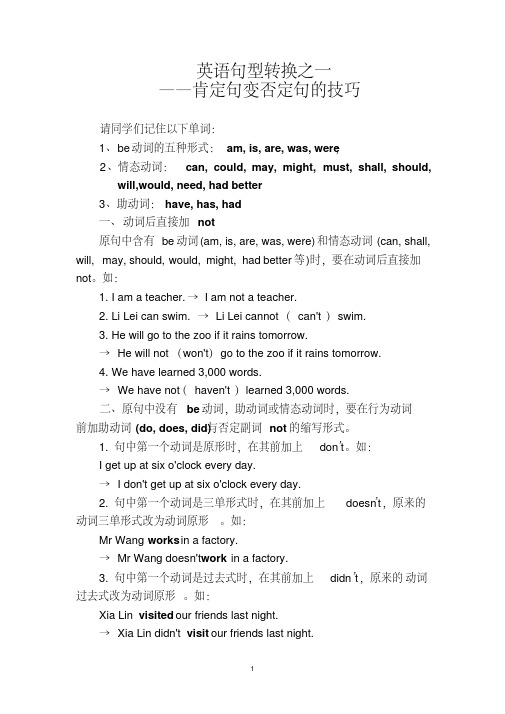
英语句型转换之一——肯定句变否定句的技巧请同学们记住以下单词:1、be动词的五种形式:am, is, are, was, were;2、情态动词:can, could, may, might, must, shall, should,will,would, need, had better3、助动词:have, has, had一、动词后直接加not原句中含有be动词(am, is, are, was, were) 和情态动词(can, shall, will, may, should, would, might, had better等)时,要在动词后直接加not。
如:1. I am a teacher. →I am not a teacher.2. Li Lei can swim. →Li Lei cannot(can't )swim.3. He will go to the zoo if it rains tomorrow.→He will not(won't)go to the zoo if it rains tomorrow.4. We have learned 3,000 words.→We have not(haven't )learned 3,000 words.二、原句中没有be动词,助动词或情态动词时,要在行为动词前加助动词(do, does, did)与否定副词not的缩写形式。
1. 句中第一个动词是原形时,在其前加上don’t。
如:I get up at six o'clock every day.→I don't get up at six o'clock every day.2. 句中第一个动词是三单形式时,在其前加上doesn’t,原来的动词三单形式改为动词原形。
如:Mr Wang works in a factory.→Mr Wang doesn't w ork in a factory.3. 句中第一个动词是过去式时,在其前加上didn’t,原来的动词过去式改为动词原形。
小学英语句型转换方法大全
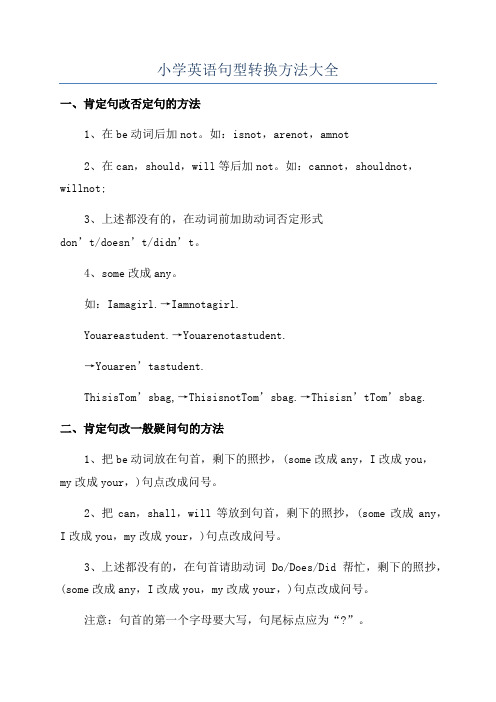
小学英语句型转换方法大全一、肯定句改否定句的方法1、在be动词后加not。
如:isnot,arenot,amnot2、在can,should,will等后加not。
如:cannot,shouldnot,willnot;3、上述都没有的,在动词前加助动词否定形式don’t/doesn’t/didn’t。
4、some改成any。
如:Iamagirl.→Iamnotagirl.Youareastudent.→Youarenotastudent.→Youaren’tastudent.ThisisTom’sbag,→ThisisnotTom’sbag.→Thisisn’tTom’sbag.二、肯定句改一般疑问句的方法1、把be动词放在句首,剩下的照抄,(some改成any,I改成you,my改成your,)句点改成问号。
2、把can,shall,will等放到句首,剩下的照抄,(some改成any,I改成you,my改成your,)句点改成问号。
3、上述都没有的,在句首请助动词Do/Does/Did帮忙,剩下的照抄,(some改成any,I改成you,my改成your,)句点改成问号。
注意:句首的第一个字母要大写,句尾标点应为“?”。
如:IaminClass6.→AreyouinClass6?YouarefromAmerica.→AreyoufromAmerica?Itisanorange.→Isitanorange?4、就一般疑问句回答一般疑问句有两种回答,即:肯定回答和否定回答。
其中,肯定回答用yes,否定回答用no。
语句顺序为:Yes+主语+am/is/are/was/were.|can.|do/does/did|;No+主语+amnot/isn’t/aren’t如:—AreyouanEnglishteacher?→Yes,Iam./No,Iamnot.—Isthatabird?→Yes,itis./No,itisn’t.三、对划线部分提问“就划线部分提问”是小学阶段英语学习的难点,但是一旦掌握了规律,就变得容易多了。
英语所有句型转换的方法[陈述句变否定句_一般疑问句特殊疑问句与练习]
![英语所有句型转换的方法[陈述句变否定句_一般疑问句特殊疑问句与练习]](https://img.taocdn.com/s3/m/9585abe7be23482fb5da4c1f.png)
英语所有句型转换的方法基本助动词只有三个:be, do, have,他们没有词汇意义,只有语法作用,如协助构成进行体,完成体,被动态,否定句,疑问句等。
一、肯定句改否定句的方法 -- 一步法1、在be动词后力口not。
如:is not ,are not ,am not,was not,were not ;2、在can,等后加not。
如:cannot3、上述都没有的,在动词前加助动词否定形式do not, does not.(don' t/doesn ' t)4、some 改成any。
二、肯定句改一般疑问句的方法——三步法1、把be动词放在句首,剩下的照抄,(some改成any,my改成your 等)句点改成问号。
2、把can,等放到句首,剩下的照抄,(some改成any,my改成your等)句点改成问号。
例如:陈述句:They are in the park. He can play theguitar..一般疑问句:Are they in the park? Can he play theguitar?把下列句子变成一般疑问句1. I am liste ning to music.2. Mike is a stude nt.3. Sarah can clea n the classroom.4. They are in the zoo.5. There are some flowers in the vase.6. This is my sister.7. We are sweep ing the floor.3、上述都没有的,在句首请助动词Do/Does帮忙,剩下的照抄,(some 改成any, my改成your等)句点改成问号。
例如:陈述句:I like the ducks. He likes the dogs.一般疑问句:Do you like the ducks? Does he like the dogs?把下列句子改为一般疑问句。
英语所有句型转换的方法陈述句变否定句一般疑问句特殊疑问句及练习

英语所有句型转换的方法基本助动词只有三个:be, do, have, 他们没有词汇意义,只有语法作用,如协助构成进行体,完成体,被动态,否定句,疑问句等。
一、肯定句改否定句的方法——一步法1、在be动词后加not。
如:is not ,are not ,am not,was not,were not;2、在can,等后加not。
如:cannot3、上述都没有的,在动词前加助动词否定形式do not, does not. (don’t/doesn’t)4、some 改成any。
二、肯定句改一般疑问句的方法——三步法1、把be动词放在句首,剩下的照抄,(some 改成any,my改成your等)句点改成问号。
2、把can,等放到句首,剩下的照抄,(some 改成any,my改成your等)句点改成问号。
例如:陈述句: They are in the park. He can play the guitar.. 一般疑问句: Are they in the park? Can he play the guitar?把下列句子变成一般疑问句1. I am listening to music._______________________________________2. Mike is a student._______________________________________3. Sarah can clean the classroom.________________________________________4. They are in the zoo.________________________________________5. There are some flowers in the vase.________________________________________6.This is my sister._________________________________________7.We are sweeping the floor.__________________________________________3、上述都没有的,在句首请助动词Do/Does帮忙,剩下的照抄,(some 改成any,my改成your等)句点改成问号。
小升初英语句型转换方法总结
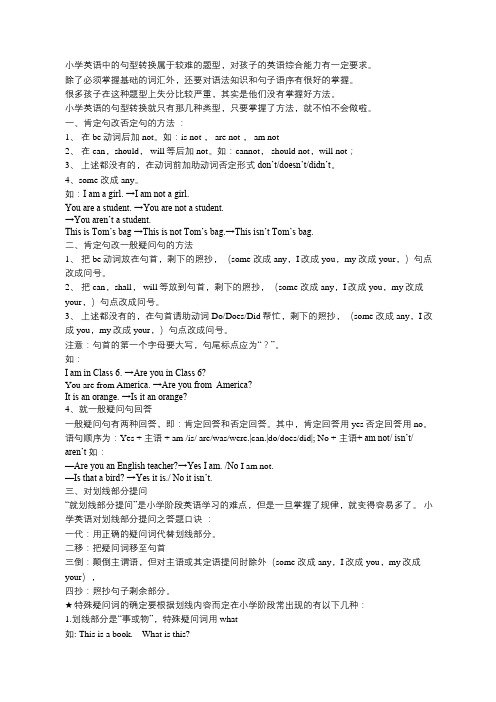
小学英语中的句型转换属于较难的题型,对孩子的英语综合能力有一定要求。
除了必须掌握基础的词汇外,还要对语法知识和句子语序有很好的掌握。
很多孩子在这种题型上失分比较严重,其实是他们没有掌握好方法。
小学英语的句型转换就只有那几种类型,只要掌握了方法,就不怕不会做啦。
一、肯定句改否定句的方法:1、在be动词后加not。
如:is not , are not , am not2、在can,should, will等后加not。
如:cannot, should not,will not;3、上述都没有的,在动词前加助动词否定形式don’t/doesn’t/didn’t。
4、some 改成any。
如:I am a girl. →I am not a girl.You are a student. →You are not a student.→You aren’t a student.This is Tom’s bag →This is not Tom’s bag.→This isn’t Tom’s bag.二、肯定句改一般疑问句的方法1、把be动词放在句首,剩下的照抄,(some 改成any,I改成you,my改成your,)句点改成问号。
2、把can,shall, will等放到句首,剩下的照抄,(some 改成any,I改成you,my改成your,)句点改成问号。
3、上述都没有的,在句首请助动词Do/Does/Did帮忙,剩下的照抄,(some 改成any,I改成you,my改成your,)句点改成问号。
注意:句首的第一个字母要大写,句尾标点应为“?”。
如:I am in Class 6. →Are you in Class 6?You are from A merica. →Are you from America?It is an orange. →Is it an orange?4、就一般疑问句回答一般疑问句有两种回答,即:肯定回答和否定回答。
英语句型转换方法大全

英语句型转换方法大全英语中的句型转换属于较难的题型,对孩子的英语综合能力有一定要求。
除了必须掌握基础的词汇外,还要对语法知识和句子语序有很好的掌握。
一、肯定句改否定句的方法:1、在be动词后加not。
如:is not,are not,am not2、在can,should,will等后加not。
如:can not,should not,will not;3、上述都没有的,在动词前加助动词否定形式don’t/doesn’t/didn’t。
4、some改成any。
如:I am a girl.→ I am not a girl.You are a student.→You are not a student.→You aren’t a student.This is Tom’s bag,→This is not Tom’s bag.→This isn’t Tom’s bag.二、肯定句改一般疑问句的方法1、把be动词(am,is,are)放在句首,第一个字母大写,剩下的照抄,句末用问号。
(some改成any,I改成you,my改成your,)句点改成问号。
2、把can,shall,will等放到句首,第一个字母大写,剩下的照抄,句末用问号。
(some改成any,I改成you,my改成your,)句点改成问号。
3、上述都没有的,在句首请助动词Do/Does/Did帮忙,剩下的照抄。
(some改成any,I改成you,my改成your,)句点改成问号。
❖注意:句首的第一个字母要大写,句尾标点应为“?”。
如:I am in Class 6.→ Are you in Class 6?You are from America.→ Are you from America?It is an orange.→ Is it an orange?4、就一般疑问句回答一般疑问句有两种回答,即:肯定回答和否定回答。
其中,肯定回答用yes,否定回答用no。
(完整版)小学英语肯定句变否定句方法及练习
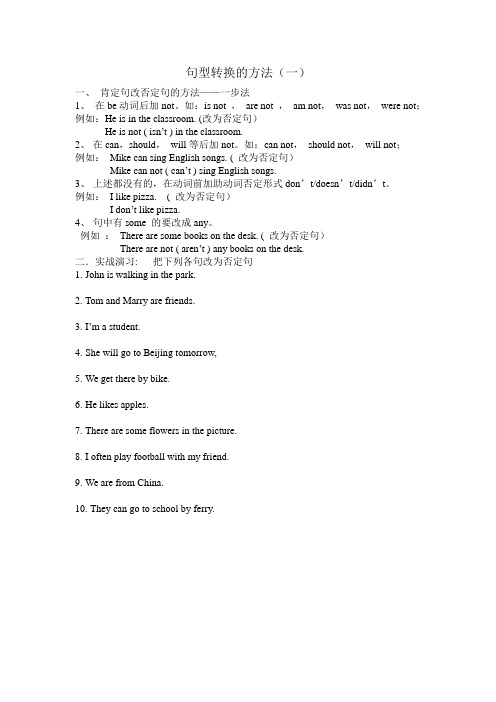
句型转换的方法(一)一、肯定句改否定句的方法——一步法1、在be动词后加not。
如:is not ,are not ,am not,was not,were not;例如:He is in the classroom. (改为否定句)He is not ( isn’t ) in the classroom.2、在can,should,will等后加not。
如:can not,should not,will not;例如:Mike can sing English songs. ( 改为否定句)Mike can not ( can’t ) sing English songs.3、上述都没有的,在动词前加助动词否定形式don’t/doesn’t/didn’t。
例如:I like pizza. ( 改为否定句)I don’t like pizza.4、句中有some 的要改成any。
例如:There are some books on the desk. ( 改为否定句)There are not ( aren’t ) any books on the desk.二.实战演习: 把下列各句改为否定句1.John is walking in the park.__________________________________2.Tom and Marry are friends.___________________________________3.I’m a student.___________________________________4.She will go to Beijing tomorrow,___________________________________5.We get there by bike.___________________________________6.He likes apples.___________________________________7.There are some flowers in the picture.__________________________________8.I often play football with my friend.__________________________________9.We are from China.__________________________________10.They can go to school by ferry._________________________________。
英语所有句型转换的方法(陈述句变否定句-一般疑问句特殊疑问句及练习)

英语所有句型转换的方法基本助动词只有三个:be, do, have, 他们没有词汇意义,只有语法作用,如协助构成进行体,完成体,被动态,否定句,疑问句等。
一、肯定句改否定句的方法——一步法1、在be动词后加not。
如:is not ,are not ,am not,was not,were not;2、在can,等后加not。
如:cannot3、上述都没有的,在动词前加助动词否定形式do not, does not. (don’t/doesn’t)4、some 改成any。
二、肯定句改一般疑问句的方法——三步法1、把be动词放在句首,剩下的照抄,(some 改成any,my改成your等)句点改成问号。
2、把can,等放到句首,剩下的照抄,(some 改成any,my改成your等)句点改成问号。
例如:陈述句: They are in the park. He can play the guitar.. 一般疑问句: Are they in the park? Can he play the guitar?把下列句子变成一般疑问句1. I am listening to music._______________________________________2. Mike is a student._______________________________________3. Sarah can clean the classroom.________________________________________4. They are in the zoo.________________________________________5. There are some flowers in the vase.________________________________________6.This is my sister._________________________________________7.We are sweeping the floor.__________________________________________3、上述都没有的,在句首请助动词Do/Does帮忙,剩下的照抄,(some 改成any,my改成your等)句点改成问号。
英语句型转换的技巧和方法
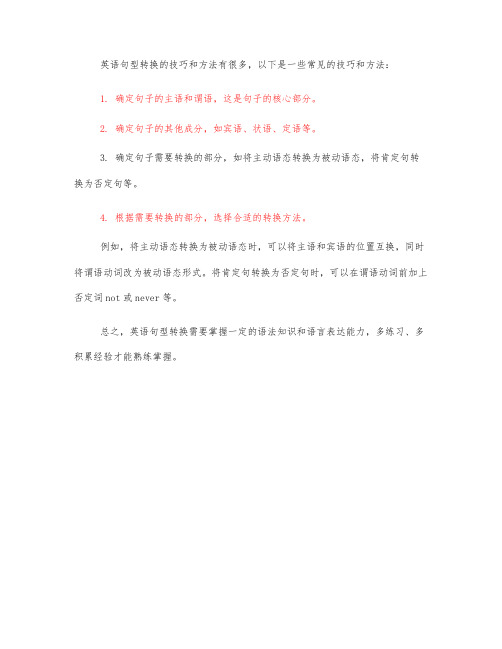
英语句型转换的技巧和方法有很多,以下是一些常见的技巧和方法:
1. 确定句子的主语和谓语,这是句子的核心部分。
2. 确定句子的其他成分,如宾语、状语、定语等。
3. 确定句子需要转换的部分,如将主动语态转换为被动语态,将肯定句转换为否定句等。
4. 根据需要转换的部分,选择合适的转换方法。
例如,将主动语态转换为被动语态时,可以将主语和宾语的位置互换,同时将谓语动词改为被动语态形式。
将肯定句转换为否定句时,可以在谓语动词前加上否定词not或never等。
总之,英语句型转换需要掌握一定的语法知识和语言表达能力,多练习、多积累经验才能熟练掌握。
小学英语句型转换详解
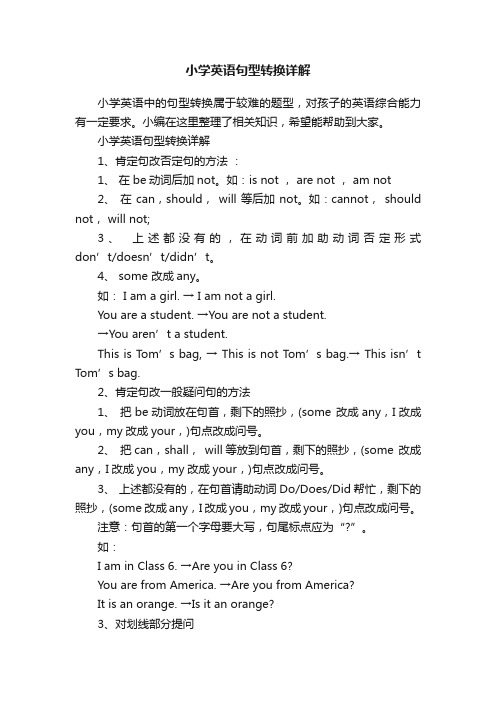
小学英语句型转换详解小学英语中的句型转换属于较难的题型,对孩子的英语综合能力有一定要求。
小编在这里整理了相关知识,希望能帮助到大家。
小学英语句型转换详解1、肯定句改否定句的方法:1、在be动词后加not。
如:is not , are not , am not2、在can,should,will等后加not。
如:cannot,should not, will not;3、上述都没有的,在动词前加助动词否定形式don’t/doesn’t/didn’t。
4、 some 改成any。
如:I am a girl. → I am not a girl.You are a student. →You are not a student.→You aren’t a student.This is Tom’s bag, → This is not Tom’s bag.→ This isn’t Tom’s bag.2、肯定句改一般疑问句的方法1、把be动词放在句首,剩下的照抄,(some 改成any,I改成you,my改成your,)句点改成问号。
2、把can,shall,will等放到句首,剩下的照抄,(some 改成any,I改成you,my改成your,)句点改成问号。
3、上述都没有的,在句首请助动词Do/Does/Did帮忙,剩下的照抄,(some 改成any,I改成you,my改成your,)句点改成问号。
注意:句首的第一个字母要大写,句尾标点应为“?”。
如:I am in Class 6. →Are you in Class 6?You are from America. →Are you from America?It is an orange. →Is it an orange?3、对划线部分提问“就划线部分提问”是小学阶段英语学习的难点,但是一旦掌握了规律,就变得容易多了。
小学英语对划线部分提问之答题口诀:一代:用正确的疑问词代替划线部分。
英语句型转换方法大全
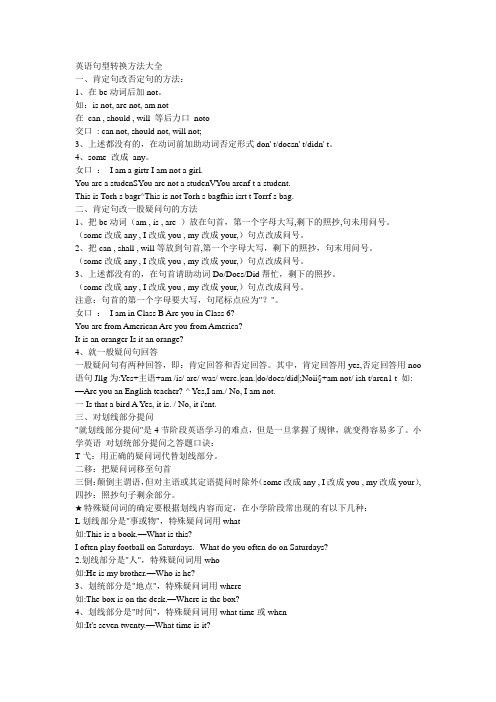
英语句型转换方法大全一、肯定句改否定句的方法:1、在be动词后加not。
如:is not, are not, am not在can , should , will 等后力口noto交口: can not, should not, will not;3、上述都没有的,在动词前加助动词否定形式don' t/doesn' t/didn' t。
4、some 改成any。
女口:I am a girtr I am not a girl.You are a studenSYou are not a studenVYou arenf t a student.This is Torh s bagr^This is not Torh s bagfhis isrt t Torrf s bag.二、肯定句改一股疑问句的方法1、把be动词(am , is , are )放在句首,第一个字母大写,剩下的照抄,句未用问号。
(some改成any , I改成you , my改成your,)句点改成问号。
2、把can , shall , will等放到句首,第一个字母大写,剩下的照抄,句末用问号。
(some改成any , I改成you , my改成your,)句点改成问号。
3、上述都没有的,在句首请助动词Do/Does/Did帮忙,剩下的照抄。
(some改成any , I改成you , my改成your,)句点改成问号。
注意:句首的第一个字母要大写,句尾标点应为"?"。
女口:I am in Class B Are you in Class 6?You are from American Are you from America?It is an oranger Is it an orange?4、就一般疑问句回答一股疑问句有两种回答,即:肯定回答和否定回答。
其中,肯定回答用yes,否定回答用noo 语句Jllg为:Yes+主语+am /is/ are/ was/ were.|can.|do/does/did|;Noii§+am not/ ish t/aren1 t 如: —Are you an English teacher?-^ Yes,I am./ No, I am not.一Is that a bird A Yes, it is. / No, it i'snt.三、对划线部分提问"就划线部分提问"是4节阶段英语学习的难点,但是一旦掌握了规律,就变得容易多了。
小学英语语法专项之肯定句变否定句

——肯“be动词”型,直接在be动词后加not,其它照抄不 变。
be动词包括:am ,is ,are ,was ,were .
I am a student. → I am not a student.
He is a boy. → He is not/isn't a boy.
7. We did morning exercises yesterday. We didn’ t do morning exercises yesterday.
8.My sister likes apples and pears.
My sister doesn’t like apples or pears.
2.The girl can sing and dance. The girl can't sing or dance.
2.I want to have an apple ,too . I don’t want to have an apple ,either .
肯定句变否定句
相关练习:
1.Mike would like some chicken.→ Mike w_o_u_l_d_n_'t like __a_n_y__ chicken.
肯定句变否定句的方法
注意缩写: is not = isn't, are not = aren't , was not = wasn't, were not = weren't, am not没有缩写, 但是I am = I'm can not = can't, would not = wouldn't
肯定句变否定句的方法
英语所有句型转换的方法(陈述句变否定句一般疑问句特殊疑问句及练习)

英语所有句型转换的方法基本助动词只有三个:be, do, have, 他们没有词汇意义,只有语法作用,如协助构成进行体,完成体,被动态,否定句,疑问句等。
一、肯定句改否定句的方法——一步法1、在be动词后加not。
如:is not ,are not ,am not,was not,were not;2、在can,等后加not。
如:cannot3、上述都没有的,在动词前加助动词否定形式do not, does not. (don’t/doesn’t)4、some 改成any。
二、肯定句改一般疑问句的方法——三步法1、把be动词放在句首,剩下的照抄,(some 改成any,my改成your等)句点改成问号。
2、把can,等放到句首,剩下的照抄,(some 改成any,my改成your等)句点改成问号。
例如:陈述句: They are in the park. He can play the guitar.. 一般疑问句: Are they in the park? Can he play the guitar?把下列句子变成一般疑问句1. I am listening to music._______________________________________2. Mike is a student._______________________________________3. Sarah can clean the classroom.________________________________________4. They are in the zoo.________________________________________5. There are some flowers in the vase.________________________________________is my sister._________________________________________are sweeping the floor.__________________________________________3、上述都没有的,在句首请助动词Do/Does帮忙,剩下的照抄,(some 改成any,my改成your等)句点改成问号。
小学英语句型转换方法及练习题
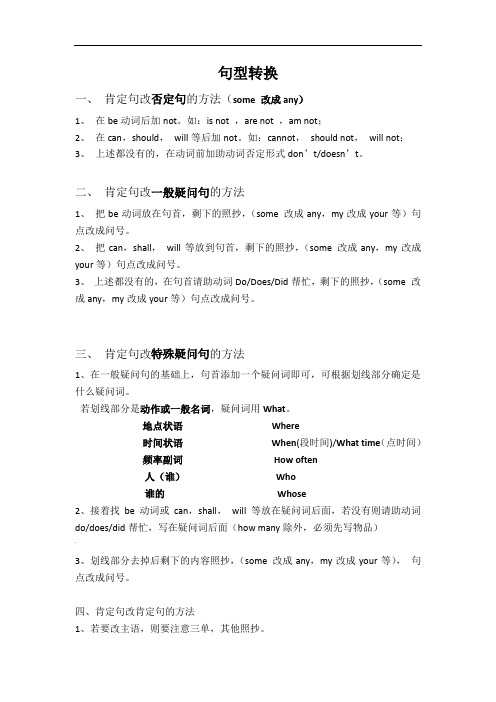
句型转换一、肯定句改否定句的方法(some 改成any)1、在be动词后加not。
如:is not ,are not ,am not;2、在can,should,will等后加not。
如:cannot,should not,will not;3、上述都没有的,在动词前加助动词否定形式don’t/doesn’t。
二、肯定句改一般疑问句的方法1、把be动词放在句首,剩下的照抄,(some 改成any,my改成your等)句点改成问号。
2、把can,shall,will等放到句首,剩下的照抄,(some 改成any,my改成your等)句点改成问号。
3、上述都没有的,在句首请助动词Do/Does/Did帮忙,剩下的照抄,(some 改成any,my改成your等)句点改成问号。
三、肯定句改特殊疑问句的方法1、在一般疑问句的基础上,句首添加一个疑问词即可,可根据划线部分确定是什么疑问词。
若划线部分是动作或一般名词,疑问词用What。
地点状语Where时间状语When(段时间)/What time(点时间)频率副词How often人(谁)Who谁的Whose2、接着找be动词或can,shall,will等放在疑问词后面,若没有则请助动词do/does/did帮忙,写在疑问词后面(how many除外,必须先写物品)'3、划线部分去掉后剩下的内容照抄,(some 改成any,my改成your等),句点改成问号。
四、肯定句改肯定句的方法1、若要改主语,则要注意三单,其他照抄。
2、若要改事态,则要注意现在进行时be动词+ving,时间为now;一般现在时直接用动词,注意三单,频率副词:always、often、usually、never。
一、肯定句改否定句1.I like playing badminton.(改为一般疑问句,并作肯定回答)2.Tom runs all the way to school.(改为否定句)#3. The benches are very clean. (改为否定句,不改变句意)The benches very .二、肯定句改一般疑问句1.Peter likes playing badminton. (改为一般疑问句,并作肯定回答)2.A parrot eats corn. (改为一般疑问句,并作肯定回答)ura wants to buy some cherries. (改成一般疑问句)Laura to buy cherries4. He likes bones very much. (改成一般疑问句并做否定回答)._______ ______ ______ ______very much _______ , he ________三、肯定句改特殊疑问句1.I like playing badminton. (划线提问)2.I like playing badminton. (划线提问)3.Ginger eats fish. (划线提问)4.I’m in my study.(划线提问)5.Sally chats with her parents. (划线提问)/6. Henry runs away. (对划线部分提问)What Henry7. My shadow grows short. (用long改写选择疑问句)shadow grow short8. Min eats Mog’s food.(划线部分提问)________ _________ _________ Min ________9. Mrs Chen is reading in the living room. (对划线部分提问)is Mrs Chen10. Ben washes his face at seven o’clock.(对划线部分提问)_________ _________ _________ Ben _________his face…11. Peter usually goes to school with his friends.(对划线部分提问)四、肯定句改肯定句1.I like playing badminton.(把主语改为Alice)2.It’s time for music class. (改为同义句)3.My dad is telling me a lot about the stars now. (用usually 代替now)4.Peter often talks to his friends. (用now代替often)5.It’ time for bed.(同义句)It’s time _______ ________ ________ ________.6. 他们通常在周末做什么(中译英)_________ _______they _________ _________ _________ _________ 7. I brush my teeth at half past seven. (把I 改成Sally)8. It’s time for having lunch.(改为同义句)。
英语句型转换之一肯定句变否定句的方法技巧

英语句型转换之一肯定句变否定句的方法技巧转换句型从肯定句到否定句,可以使用以下方法和技巧:
1. 在动词前加上否定副词:例如,I can swim.(我会游泳。
)变为
I cannot swim.(我不会游泳。
)
2. 使用 do not/does not/did not 加上动词的原形:例如,He likes coffee.(他喜欢咖啡。
)变为 He does not like coffee.(他不喜欢咖啡。
)
3. 在助动词前加上 not:例如,She is watching TV.(她在看电视。
)变为 She is not watching TV.(她不在看电视。
)
4. 将 be 动词转换为它的否定形式:例如,They are here.(他们在这里。
)变为 They are not here.(他们不在这里。
)
5. 在句子中使用反义词或否定概念的词来表示否定:例如,The weather is good.(天气很好。
变为 The weather is not bad.(天气不差。
这些是转换从肯定句到否定句的常见方法和技巧。
根据句子的不同结构和语境,可能需要使用不同的方法来转换句子。
英语所有句型转换的方法(陈述句变否定句一般疑问句特殊疑问句及练习)

英语所有句型转换的⽅法(陈述句变否定句⼀般疑问句特殊疑问句及练习)英语所有句型转换的⽅法基本助动词只有三个:be, do, have, 他们没有词汇意义,只有语法作⽤,如协助构成进⾏体,完成体,被动态,否定句,疑问句等。
⼀、肯定句改否定句的⽅法——⼀步法1、在be动词后加not。
如:is not ,are not ,am not,was not,were not;2、在can,等后加not。
如:cannot3、上述都没有的,在动词前加助动词否定形式do not, does not. (don’t/doesn’t)4、some 改成any。
⼆、肯定句改⼀般疑问句的⽅法——三步法1、把be动词放在句⾸,剩下的照抄,(some 改成any,my改成your等)句点改成问号。
2、把can,等放到句⾸,剩下的照抄,(some 改成any,my改成your等)句点改成问号。
例如:陈述句: They are in the park. He can play the guitar.. ⼀般疑问句: Are they in the park? Can he play the guitar?把下列句⼦变成⼀般疑问句1. I am listening to music._______________________________________2. Mike is a student._______________________________________3. Sarah can clean the classroom.________________________________________4. They are in the zoo.________________________________________5. There are some flowers in the vase.________________________________________6.This is my sister._________________________________________7.We are sweeping the floor.__________________________________________3、上述都没有的,在句⾸请助动词Do/Does帮忙,剩下的照抄,(some 改成any,my改成your等)句点改成问号。
- 1、下载文档前请自行甄别文档内容的完整性,平台不提供额外的编辑、内容补充、找答案等附加服务。
- 2、"仅部分预览"的文档,不可在线预览部分如存在完整性等问题,可反馈申请退款(可完整预览的文档不适用该条件!)。
- 3、如文档侵犯您的权益,请联系客服反馈,我们会尽快为您处理(人工客服工作时间:9:00-18:30)。
英语句型转换之一——肯定句变否定句的技巧请同学们记住以下单词:1、be动词的五种形式:am, is, are, was, were;2、情态动词:can, could, may, might, must, shall, should,will,would, need, had better3、助动词:have, has, had一、动词后直接加not原句中含有be动词(am, is, are, was, were) 和情态动词(can, shall, will, may, should, would, might, had better等)时,要在动词后直接加not。
如:1. I am a teacher. →I am not a teacher.2. Li Lei can swim. →Li Lei cannot(can't )swim.3. He will go to the zoo if it rains tomorrow.→He will not(won't)go to the zoo if it rains tomorrow.4. We have learned 3,000 words.→We have not(haven't )learned 3,000 words.二、原句中没有be动词,助动词或情态动词时,要在行为动词前加助动词(do, does, did)与否定副词not的缩写形式。
1. 句中第一个动词是原形时,在其前加上don’t。
如:I get up at six o'clock every day.→I don't get up at six o'clock every day.2. 句中第一个动词是三单形式时,在其前加上doesn’t,原来的动词三单形式改为动词原形。
如:Mr Wang works in a factory.→Mr Wang doesn't work in a factory.3. 句中第一个动词是过去式时,在其前加上didn’t,原来的动词过去式改为动词原形。
如:Xia Lin visited our friends last night.→Xia Lin didn't visit our friends last night.三、肯定句变否定句的七点注意1. 肯定句变否定句时,除将谓语变为否定式外,句中其他词语也可能随之改变,如将some改为any,too和also改为either,already 改为yet,and改为or等。
如:There are some birds in the tree. 树上有些鸟。
→There aren’t any birds in the tree. 树上没有鸟。
He likes the girl, too. 他也喜欢这个女孩。
→He doesn’t like the girl, either. 他也不喜欢这个女孩。
We have already seen the film. 我们已看过这部电影。
→We have not seen the film yet. 我们没有看这部电影。
He likes singing and dancing. 他喜欢唱歌和跳舞。
→He doesn’t like singing or dancing. 他不喜欢唱歌和跳舞。
2. 复合句的肯定式变否定式a. 在含有宾语从句的主从复合句中,当主句的主语是第一人称,谓语动词是think, believe, guess时,如果要否定后面的宾语从句,习惯上否定主句的谓语动词。
如:I think he is 13 years old.→I don't think he is 13 years old.I believe she will come here soon.→I don’t believe she will come here soonb. 其他一般将主句变为否定式。
如:I was cooking when Mum got home.→I was not cooking when Mum got home.3. 不变谓语动词而变其他词语a. 肯定句中含有both, both …and时,变否定句时both →neither;both …and→neither …nor;all→none。
如:Both of us are students. all→Neither of us is a student.I know both English and Chinese.→I know neither English nor Chinese.All of them like bananas. →None of them like(s) bananas.b. 肯定句中含有every-, some- 的合成词,变否定句时常改为含有no- 的合成词。
如:Everything is ready. →Nothing is ready.There is something wrong with my bike.→There is nothing wrong with my bike.c. 肯定句中含有“形容词+enough to do sth.”,变否定句时改为“too +形容词的反义词+to do sth.”。
如:She is old enough to go to school.→She is too young to go to school.d. 肯定句中含有always 和ever ,变否定句时改为never 。
如:He is always late for school. →He is never late for school.My uncle's ever been to many parts of England.→My uncle has never been to many parts of England.4. 祈使句的肯定式变否定式a. 一般情况下,在句首的动词前加Don't 。
如:Close the door. →Don't close the door.b. 以Let's 或Let us 开头的祈使句,在变否定句时常在其后加not;有时也可在其前加Don't 。
如:Let me try again.→Let me not try again.→Don't let me try again.5. 动词不定式变否定式时,常在不定式符号to 前加not 。
如:The teacher asked me to speak more loudly.→The teacher asked me not to speak more loudly.6. 部分否定与完全否定比较以下句子:All of us laughed when we heard it. 听到这事时我们都笑了。
(肯定句)All of us didn’t laugh when we heard it. 听到这事时我们并未都笑。
(部分否定)Not all of us laughed when we heard it. 听到这事时我们并未都笑。
(部分否定)None of us laughed when we heard it. 听到这事时我们都没笑。
(完全否定)注:可能涉及部分否定的词语有both, all, always, every等,即not both表示“并非两者都”,not all 表示“并非所有的都”,not always 表示“并非总是”,not every表示“并非每个…都”。
7. 需要分清do, does, did, have, has, have, had等是实义动词还是助动词。
如果是助动词,则在它们后面直接加not,如果是实义动词,则在它们前面根据实际情况加don’t, doesn’t或didn’t 。
如:He usually does his homework in the evening.→He usually doesn’t his homework in the evening.(Wrong)→He doesn’t usually do his homework in the evening.(Right)Tina has gone home.→Tina doesn’t have gone home.(Wrong)→Tina hasn’t gone home.(Right)把下面的句子变成否定句1. The old man hurt his leg last Wednesday. (西宁市中考题)2. Both Joy and Sam like singing Beijing Opera. (新疆中考题)3. His mother has already called the police for help. (乌鲁木齐市中考题)4. He knows everything about your school.5. Put them over there.6. He likes the girl, too.7. A lot of people are lying on the beach.8. He does some reading on Sunday.9. They like singing and dancing.10. Cindy did her homework last night.11. We had some money for the taxi.12. There are some students in the classroom.13. This pop singer has a new look.14. I think he is great.15. You can listen to music after school.16. I have to make lunch at home.。
